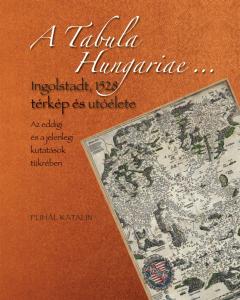
The Tabula Hungariae... Ingolstadt – 1528
The Tabula Hungariae… Ingolstadt, 1528 Map and its Afterlife
Written by Katalin Plihál
NSZL–Kossuth Publishing House, Budapest, 2013., 224 pages
ISBN 978 963 200 613 0
It was in May 1528 that the first product of the new printing press of Petrus Apianus in Ingolstadt, Tabula Hungariae, was published.
The preservation and the very publication of this map was, to use modern language, an international project. The original map was made by the Hungarian Lazarus secretarius, and then got to Vienna thanks to Frankish-born Austrian diplomat Johannes Cuspinianus. Once there, it was prepared for printing by the professor of the Vienna University, the Bavarian Georg Tannstetter, and then Petrus Apianus who was also Bavarian, made it available for the wide public using an amazing new map-printing method, stereotyping. The cost of publishing was assumed by the same person who discovered this treasure in the first place, Cuspinianus.
In 2007, as a result of a similar international joint effort, Tabula Hungariae was included in the UNESCO Memory of the World program that aims at preserving the world’s cultural heritage.
When the map was published for the first time, only some dozens of copies got to the market, so there are no exact data kept about it in old catalogues. That is why there was no actual knowledge of it in spite of a keen search until 3 May 1880 when renowned bibliophile Count Sándor Apponyi finally presented it to the public.
Even the experts were surprised by the unusual orientation of this map of the medieval Hungarian Kingdom, and were uncertain about the identity and descent of the author as well as of how long it had taken to him to create this outstanding work.
Tabula Hungariae… Ingolstadt, 1528 is an important representation of the natural and economical resources of medieval Hungary, and also an exceptional language relic.
Our book reveals the background of this unique treasure. The author presents the results of her 25 years research guiding the reader through the information highway of data-flow along which the derivatives of this map of 1528 were released.
A DVD-ROM is added to the book with related maps, documents, and a summary in English to facilitate detailed research.
The publication is a joint project of National Széchényi Library and Kossuth Publishing House, supported by the National Cultural Fund of Hungary.
Shopping
Our publications are available in our bookshop, or can be ordered from the Publications Department of the NSZL using the contact details below: Főigazgatói Kabinet kiadványtára, Országos Széchényi Könyvtár, 1276 Budapest P.O. box 1205., phone: 06 1 232-3556, e-mail: kiadvanytar@oszk.hu.




